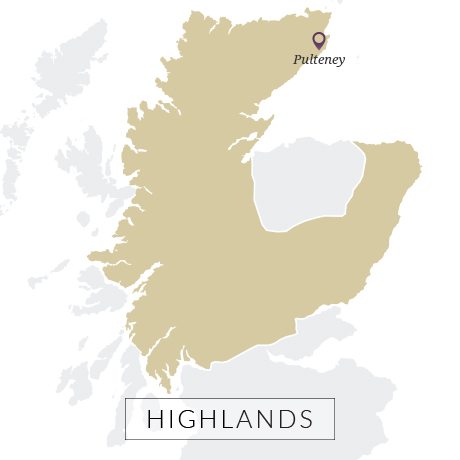Balblair
One of the prettiest distilleries.


Pulteney’s wash still has a massive boil bulb almost as large as the base of the still and a flat top. This helps to produce high levels of reflux and separate specific alcohols. The spirit still has both a purifier pipe and a very convoluted, coiling lyne arm. Again, reflux is maximised here, with that purifier conceivably adding oiliness to the character. Condensing takes place in worm tubs which add weight.
Old Pulteney (as the brand is named) demonstrates this balance between the heavy, leathery and oily, with a fragrant almost ozonic freshness.

From the late 18th century until the start of WWI, the northern port of Wick was the capital of the herring trade. Its huge harbour was built in 1808 and a decade later 822 boats were operating out of the port. By 1860 that number had risen to over 1,000.
This explosion in trade in turn necessitated housing and in 1810 Thomas Telford built a new town on the south bank of the river which he named Pulteneytown after Sir William Pulteney MP, who as head of the Fisheries Board was instrumental in Wick’s expansion.
This rapid increase in population then, inevitably, cried out for a distillery and in 1825, James Henderson, who had been distilling out of sight of the law in Stemster, moved into Pulteneytown and started making whisky.
The Henderson family retained ownership for almost a century before selling in 1920 to Jas. Watson of Dundee. Two years later under the influence of an American evangelist, the Wick town council voted to make the town a ‘dry’ one with no sales of alcohol permitted. Whether this had any influence on Graham is unclear, but in 1924 Old Pulteney had been passed on to John Dewar & Sons and from there was brought within DCL. The distillery remained in production until 1930 when a downturn in the market forced it to close.
Its doors re-opened in 1951 – four years after Wick’s ‘Prohibition’ ended – when local businessman Robert ‘Bertie’ Cumming bought it. He sold it and his other distillery, Balblair, to Canadian giant Hiram Walker in 1955 and from there through a series of mergers it ended up in the Allied Distillers’ stable. When Allied sold it and Balblair to Inver House in 1995 it was in dire need of repair.
Since then, the distillery has been renovated, a visitors’ centre has opened and the Old Pulteney brand has been successfully established.